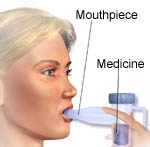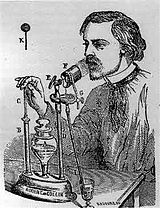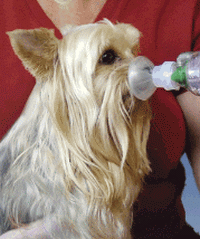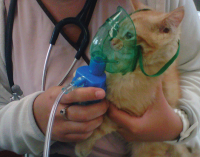sursa: https://altered-states.net/barry/update355/

Nebulizers are used to aerate water soluble medicines dissolved in water into a fine mist tolerable for inhalation in a constant & steady concentration until the medicine has been completely delivered.
"At the Ohio State University Medical Center, pharmacists, respiratory therapists, and pulmonologists endorse what they call off-label nebulization. Off-label nebulization is a rapidly growing area of patient care and in time new research and practical experience will bring us much more information on how magnesium and other agents like sodium bicarbonate, iodine, peroxide and glutathione can be administered directly into the lungs for many difficult-to-treat conditions. Even DMSO has been used in veterinarian medicine and naturopaths have used Tea Tree Oil from Australia, which is used topically as fungicide antiseptic and germicide. Eucalyptus oil has also been used forever because it is a known bronchial-dilator." Source
A nebulizer is a machine that turns liquid medicine into a mist so that it can be inhaled, according to the American Thoracic Society. Often used for the treatment of asthma, the mist is easily inhaled and acts more quickly than other methods of medication delivery.
|
Nebulizers changes liquid (medicine) into fine droplets (in aerosol or mist form) that are inhaled through a mouthpiece or mask. Nebulizers can be used to deliver bronchodilator (airway-opening) medicines such as albuterol (Ventolin, Proventil or Airet) or ipratropium bromide (Atrovent). ( Stop reading if you ever used any of those. ) Nebulizers are also an excellent delivery method for introducing Colloidal Silver directly into the nose and lungs. A nebulizer may be used instead of a spray bottle or nasal inhaler.
Nebulizers use oxygen, compressed air or ultrasonic power to break up solutions and suspensions into small aerosol droplets that can be directly inhaled from the mouthpiece of the device. The definition of an aerosol is a "mixture of gas and liquid particles," and the best example of a naturally-occurring aerosol is mist, formed when small vaporized water particles mixed with hot ambient air are cooled down and condense into a fine cloud of visible airborne water droplets.
So after I was suffering for 10 days with a cold myself that wouldn't go away I thought I'd try taking buffered Vitamin C (sodium ascorbate) via a nebulizer.
It did relieve congestion considerably, and if I slept right after then it seemed to have a longer lasting effect.
|
Nebulisers are not some hippy, new age alterenative tool
"Sometimes very sick people or even animals with a lung ailment do better when taking drugs by nebulization as opposed to orally, because then the embattled system doesn’t need to go through breaking down the medications in the stomach and then delivering them to the lungs through the blood stream. With nebulization medicines get sprayed directly onto the lung tissues where they can most easily be absorbed locally by the lung and brachial cells."
Medicines given using a nebulizer:
• Antibiotics: These medicines fight lung infections caused by bacteria. They may before diseases such as cystic fibrosis and bronchiectasis. These medicines improve lung function and decrease symptoms.
• Antibiotics: These medicines fight lung infections caused by bacteria. They may before diseases such as cystic fibrosis and bronchiectasis. These medicines improve lung function and decrease symptoms.
| "Ok, this may seem like a dumb idea for a post, but my little girly is sick and is having breathing trouble and I've discovered via the net a way I can help her without giving her steroids or chemicals,My doc said that I should put saline in a nebulizer and let her breathe in the salt water solution... and they usually sell saline in pharmacies for this purpose among others..." Homemade Saline Solution Recipe Ingredients: 1 cup water (ideally filtered) 1 tsp salt Instructions: 1. Bring water to a boil. Boil for 10 minutes to get rid of any impurities. 2. Mix salt into the water and stir until dissolved. 3. Let the saline mixture cool. more  |
• Bronchodilators: These medicines stop body reflexes that make your airways smaller, to help you to breathe easier. Their effects may last for 4 to 6 hours (short acting) or for 12 hours (long acting). You may feel that your heart is beating faster or that your hands are shaking after using them. They may blur your vision for a short time or worsen glaucoma if they go to your eyes. Close your mouth when inhaling these medicines to prevent this. Dry mouth, another side effect, can be avoided by rinsing your mouth and spitting out the rinse water.
"A randomized, double-blind, controlled clinical study compared nebulized magnesium sulfate with nebulized albuterol in 33 patients with asthma (ages 12–60 years).[6] The study concluded that the serial doses of nebulized magnesium sulfate had bronchodilatory effects similar to those noted with nebulized albuterol."
|
• Corticosteroids: These drugs decrease the inflammation in your airways. They may help if you often have trouble breathing from a long-term lung disease. You may be instructed to inhale a bronchodilator first before using this medicine to prevent spasm (fast tightening) in your airways. You may get a fungal infection in your mouth when you use this medicine often. Rinse your mouth every time after you use this medicine.
Nebulizer & glutathione: I have found nebulized glutathione to be incredible for my lungs. I have been doing glutathione IV's for mopping up toxins from lyme disease. I started doing nebulized glutathione to get it in my blood between IV's. I recently had a cold and in the past it always caused a severe lung infection and bronchitis. It would take months to get back to normal. With the glutathione inhalation, there was much less sign of lung infection, and the bronchitis was so minimal, I was back to normal in 2-3 weeks instead of months. Source
|
• Prostanoids: These drugs relax blood vessels and increase blood flow and oxygen to damaged areas of the lungs. They are used in those with severe (very bad) lung infection or sudden airway problems.
 |
The first "powered" or pressurized inhaler was invented in France by Sales-Girons in 1858. This device used pressure to atomize the liquid medication. The pump handle is operated like a bicycle pump. When the pump is pulled up, it draws liquid from the reservoir, and upon the force of the user's hand, the liquid is pressurized through an atomizer, to be sprayed out for inhalation near the user's mouth.[4]
|
I'm a big fan of nebulizing colloidal silver. It gets the silver directly into the bloodstream via the lungs, bypassing the stomach.
| Magnesium chloride oil should be nebulized as an isotonic solution – delivering 7.5g magnesium chloride per 100ml of distilled water – closely equal to 3.5 tsp of magnesium oil per 100ml. Nebulization of magnesium is an alternative method of treatment for patients with pulmonary problems or infections, or for those undergoing bronchoscopy. Magnesium nebulized directly into the lungs offers all the same positive therapeutic effects that other types of administration methods do but concentrates the effects in the lung and bronchial tissues.Source |
Nebulising colloidal silver
Dr. Victor Marcial-Vega is a board-certified oncologist and the director of Health Horizons Rejuvenation Clinic in Coral Gables, Florida.
And we have the prestigious Health Sciences Institute (HSI) to thank for bringing this to our attention.
You see, HSI addressed this very topic in an e-alert to their members, back in October 2001, shortly after the 9-11 terrorist attacks and subsequent anthrax attacks on our nation.
As the HSI pointed out at the time, one of their well-known health symposium panelists, Dr. Marcial-Vega, had discovered while dealing with pneumonia patients the fact that colloidal silver can be quickly and easily carried into the human blood stream and from there into the body's cells and tissues, simply by nebulizing it. Source

Emphysema is a terribly debilitating respiratory illness that's sometimes referred TO as COPD, or chronic obstructive pulmonary disease.
Dr. Wright discusses COPD at length, and states that nebulized, inhaled glutathione is "the No. 1 natural treatment for COPD in my practice."
E-Alert readers will recognize glutathione as the powerful antioxidant and amino acid molecule that I've written about many times. In Dr. Wright's treatment, glutathione is taken via a nebulizer; an apparatus that dispels liquid in a fine mist to be inhaled.
Dr. Wright cautions that by the time a COPD diagnosis is made, lung tissue is usually so badly damaged that nutritional treatments can't cure most cases of COPD. But he adds, "I can safely say that this type of therapy usually stops and at least partially reverses the progression of the disease. Often, improvement can be quite significant." Source
|
Nebulisation is the breaking down of a liquid into very small droplets, which in the case of medication, can be inhaled and in consequence deposited right into the problem area in the lungs. The advantage of that is that a concentrated amount can be deposited into a targeted area. An option would be to swallow the medication which in turn is absorbed through the gut into the blood and finally to the lungs. The problem with that route is that a much higher dosage would be needed to raise the level of medication in the whole body to achieve a similar result, and many other organs would be medicated.
If you are simply trying to clean the lungs out then I would go with diluted food grade hydrogen peroxide. Food grade is 35% peroxide so it needs to be diluted before use. Start by adding one ounce of the peroxide to 11 ounces of distilled water to make a 3% solution. Then you would add 5-10 drops of this to your nebulizer filled with water. I recommend doing this several times daily to help keep infections at bay and to help promote healing. Peroxides are generated by the body for a number of reasons including for the destruction of pathogens, activation of white blood cells that fight infection, destroying cancer cells, etc. But the peroxide does not need to be concentrated to perform these functions. Source CureZone.com
|
Some people use a nebuliser on their Pets
 |  | |
 |  |
Healthcare CompMist Nebulizer, is a good option for pets
A nebulizer can administer higher doses of medicine faster than taking it orally or getting a shot. You can also, with your doctor' permission, mix several medications in a nebulizer and take them all at once.
Hi - I still have amalgams, but my Environmental MD has prescribed me a nebulizer to use Glutathione and B-12 (together).
|
A nebulizer usually consists of parts that make the mist, and a machine to power the nebulizer. The machine may be mechanical or ultrasonic. A mechanical compressor makes mist from liquid medicines using compressed air that passes through a narrow hole. An ultrasonic machine makes very high speed vibrations to create a mist. The mist is made in the nebulizer in a container for the medicine that may be used again. The container or machine may have a valve that controls the flow of air to increase the amount of mist you receive. A mouthpiece or mask connects to the medicine container to bring the mist to your lungs.
I am using the same magnesium sulphate preparation for nebulisation as for injections. It is a 50% solution, which some people find slightly irritant because it may make them sneeze or cough but after a few breaths this settles down (I found it best just to inhale through the mouth and not the nose). There are no theoretical or practical reasons why anyone should get problems such as wheezing while nebulising - indeed, magnesium works well for asthma. Some patients respond clinically as well as if they'd had an injection. In fact, a study in New Zealand of magnesium by nebuliser for the treatment of acute asthma showed this to be a very effective treatment, over and above the effect of standard bronchodilators. If you feel you are getting short of breath during the nebulisation, stop the treatment. Source
|
"I have been looking all over the Web for Specific Information on Nebulizing Food Grade Hydrogen Peroxide and haven't had much success finding very good quality information, I have decided to write up what I have been doing in regards to Nebulizing Hydrogen Peroxide recently.
I have had quite severe Asthma for over 30 years and have had my fair share of trips to the Emergency Department, one trip in the back of an Ambulance to Hospital after 5 Ventolin nebs one after another didn't work!!! I've been on the Steroids, Ventolin, Preventers and all the other stupid stuff that the Medical Industry of $$$ motivated incompetence has provided us with.
I have been able to get on top of my Asthma in the past few years by Cleaning up my diet (Mostly Organic food), Lung Herbs, Doing repeated Dr Schulze Bowel, Liver and Kidney Cleanses, some Juice Fasting etc, etc...
Just recently I had been having quite a few problems with my chest for the past two months which started with some sort of Cold/Flu which got into my chest and then a particularly bad Hayfever season we have had this year. I even had to start using Ventolin again which I haven't used for the past 3-4 years.
Well after a few months of my chest messing me around and me starting to get annoyed because it wasn't getting better, so I decided to do something about my chest. One of the things I started researching was Hydrogen Peroxide Inhalation Therapy so I decided to try it for myself.
Now for me, Nebulizing Hydrogen Peroxide makes the most sense because it's going to penetrate most deeply into the lungs and help wipe out any nasties that may be lurking in there, but the question is, how much to Hydrogen Peroxide to use without irritating the already sensitive lungs.
So this is what I did, over 3 - 4 days, I nebulized 5ml of Distilled Water plus 5 - 10 drops of 3% Food Grade Hydrogen Peroxide whenever I started wheezing and experimented with taking a puff of Ventolin Inhaler 10 Minutes Before or After a H2O2 Nebulizer if I felt I needed it.
What I did find is the Hydrogen Peroxide Nebs did seem to make the Ventolin more effective and my consumption of Ventolin did decrease quite significantly once I started the H2O2 Nebs. Source
|
Nebulized Bicarbonate
The bronchial secretions during attack of bronchial asthma are acidic and the acidity imparts stickiness to the secretions and moreover there is high level of neuraminic acid, which possibly correlates with the stickiness. Thus sodium bicarbonate is an excellent choice for nebulization offering it’s powerful and instant pH changing effects. Dr. Tullio Simoncini recommends aerosol use of bicarbonate for lung and bronchial adenocarcinoma. He recommends putting 1 soupspoon sodium bicarbonate in ½ liter water and inhaling it with a fast inhaler in half an hour. Six days on six days off when in IV break phases. More
| "Nebulizer for Sinusitis Attacks bacteria in the sinuses using aerosol technologyUsing a nebulizer for sinusitis can be very effective. The nebulizer machine delivers vapourized liquid medications to the infected area. To create the vapour, the liquid medication is mixed with air, which is then topically disposed in the nasal cavity and maxillary sinuses." |
Along with longtime collaborator Nicolas Fasel, PhD, of the University of Lausanne in Switzerland, and other colleagues, Beverley discovered that Leishmania parasites infected with a virus – dubbed Leishmaniavirus – cause significantly worse disease than those without a virus. Other researchers later showed that viruses in related parasites such as Trichomonas, which causes vaginal infections, and potentially Cryptosporidium, which causes diarrhea, also may exacerbate disease. Source
My husband has COPD and Pulmonary Arterial Hypertension More
There is no mystique to nebulisation. Nebulisation for medical treatment has been around for over a century. Not in the present form but the theory was the same. A Dr De Vilbiss during the American Civil War found that swabbing the throat to relieve infection was painful and uncomfortable for the soldiers he was treating. After that war he developed an atomiser similar to the old fashioned scent spray to spray the throat, which was much less painful. One of his sons developed a compressor early in the 1900s and another son incorporated the atomiser nozzle to invent a paint spray for motorcars. The De Vilbiss Corporation, which specialised in compressor manufacture, also developed the nebuliser.
Today we have the modern development of that system. Fine-tuned and more efficient, but basically the same.